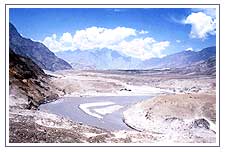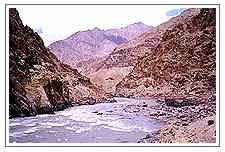It roared and spread itself, but it never hurt!
If time were called upon to tell a story, it would perhaps choose the banks
of river Indus to do so. Here, the history of India could well be marked,
both chronologically and historically.

The
Legends
It has believed by the early Tibetans that this forceful and
full river that guarded the frontiers of united India rises from the lake
Mansarovar in Tibet. A few expeditions later, it was discovered that the
Indus actually originates a few kilometres north of lake Mansarovar and
together with it arise the Brahmaputra and the river Sutlej, through
Mansarovar.
Metaphorically, the four rivers that separated from this area were
described as rising out of certain animals mouths, thereby ascribing the
qualities to the river. The Pakshu went westward in the beginning and then
came out of a horse's mouth to the east to be called the Brahmaputra.
The Sita went southwards in the beginning and then came out of a lion's
mouth to the north to be called the river Sindhu. The Ganga came out of an
elephant's mouth and the Karnali from a peacock's mouth.
The waters of the river Brahmaputra are cold and it is said that the one
who drinks these waters would become sturdy as a horse. The waters of the
Indus are warm and it is said that the one who drinks from it would become
heroic like a lion. Does that explain why invaders to India always conquered
after stopping to quench their thirst at the Indus?
Legend has it that those who drink the waters of the Ganges would become as
worthy as the elephant: with good memory, sense of gratitude, strong and
auspicious. Similarly those who drink the waters of Karnali would be come as
beautiful as the peacock. It is said these four rivers circle seven times
around Kailash (also spelt as Kailas), the divine residence of Lord Shiva
(also spelt as Siva), before gurgling down.
Derivation Of The Name - Indus
The lion river, the Indus derives its
name from the Sanskrit word, Sindhu, which means a large water body, a sea
or an ocean. In Greek, it is called "Sinthos" and in Latin, the "Sindus".
The name gradually came to represent the people who lived beyond it and the
name Hindus was born. It took less time to derive the name - Indus gave
people a lot more.
In the Rig Veda, there is a reference to "Sapta Sindhus", where
Sapta means seven and Sindhus, refers to rivers. The seven rivers are the
Indus, her five tributaries and the river Saraswati. The Rig Veda is also
said to enumerate and many medicinal plants found on the banks of the river
Indus.
The Mahabharata, another ancient Indian epic refers to Sindhu and the king
who ruled the region that nestled on the banks of the river. While dating
epics and texts are still arbitrary, the great Indus Valley Civilization at
Harappa and Mohenjodaro, now in Pakistan, are eloquent testament of the
culture and people of the region. A site similar to that and liked to that
period has been unearthed at Lothal Gujarat, India.
The Indus
Valley Civilization gave many a clue about life in the pre-Vedic times. Some
people say that the original inhabitants of the Indus Valley were Dravidians
who were shifted southwards with the coming of the Aryans. Later historical
theories totally oppose the idea of a set of Aryans who came to displace the
Dravidians. They say that the coming of people from different regions was
continuous and not an invasion as was given to be believed.

Either
way hat lasts is the richness of the Indus Valley Civilization and the
heritage bequeathed by it to later generations. Historians and ideologists
trace the beginnings of the idea of Lord Shiva to the Harappa Civilization.
The bull inscribed on the coins of Harappa is in fact, they say, symbolic of
Shiva's mount. He was worshipped in the form of "Pashupati",
the lord of animals. Researchers even go as far as finding parallels between
Sumerian Civilization and their pantheon which has counterparts of Lord
Shiva and the lady of the mountains, Goddess Parvati, Shiva's consort.
If Shiva was the metaphysical legacy in addition to worship of natural
elements like 'Agni' (fire), architecture, town planning, coins,
even figures of dancing girls are some of the others. Interesting or perhaps
circumscribing man's ability to conjecture is the fact that many of
these legacies defy immediate understanding. The Indus valley script for
example is one, which has challenged many scholars and is yet to find a
satisfactory interpretation. Travelling across the river Indus were many
cultural exchanges between Greece, in fact the rest of the world and India.
Greco-Roman art of India today is just one example.
It was on the banks of river Indus that Alexander the great invaded in the
4th century BC crossed the river by ford or bridges at the shallows to the
north of a significant place called "Attack". According to a
British administrator Attack itself meant this far and no further. There isn't
any such a meaning present in the Sanskrit dictionary, perhaps because the
English pronunciation of the word has changed it.
But in its idea, the meaning sounds good. For only after crossing river
Indus at this point could one enter the then Hindustan. And this was the
place where most of the invaders and visitors to India crossed. Akbar even
built a fort here because once when he was to cross, the river was in spate
and he had to wait a while. So he decided this place needed a shelter. Even
before that Shershah Suri, who ruled over India for a while built the grand
trunk road from Calcutta via Delhi to Lahore and Rawalpindi. It crossed the
Indus near Attack.
This water
continued to charm the people and rulers like Akbar and Jehangir built
canals from its tributaries to feed huge and beautiful Persian gardens. Even
if the Sikhs once spread their empire far enough to build another fort on
the other side of river Indus, invaders like Nadir Shah from Persia and
Mahmood of Ghazni continued to gallop and ravage the wealth of India. While
the Indus was a valiant guardian at the northwest frontier, it was not so
difficult to overpower. It roared and spread itself, but it never hurt.


 The
Legends
The
Legends Either
way hat lasts is the richness of the Indus Valley Civilization and the
heritage bequeathed by it to later generations. Historians and ideologists
trace the beginnings of the idea of Lord Shiva to the Harappa Civilization.
The bull inscribed on the coins of Harappa is in fact, they say, symbolic of
Shiva's mount. He was worshipped in the form of "Pashupati",
the lord of animals. Researchers even go as far as finding parallels between
Sumerian Civilization and their pantheon which has counterparts of Lord
Shiva and the lady of the mountains, Goddess Parvati, Shiva's consort.
Either
way hat lasts is the richness of the Indus Valley Civilization and the
heritage bequeathed by it to later generations. Historians and ideologists
trace the beginnings of the idea of Lord Shiva to the Harappa Civilization.
The bull inscribed on the coins of Harappa is in fact, they say, symbolic of
Shiva's mount. He was worshipped in the form of "Pashupati",
the lord of animals. Researchers even go as far as finding parallels between
Sumerian Civilization and their pantheon which has counterparts of Lord
Shiva and the lady of the mountains, Goddess Parvati, Shiva's consort.